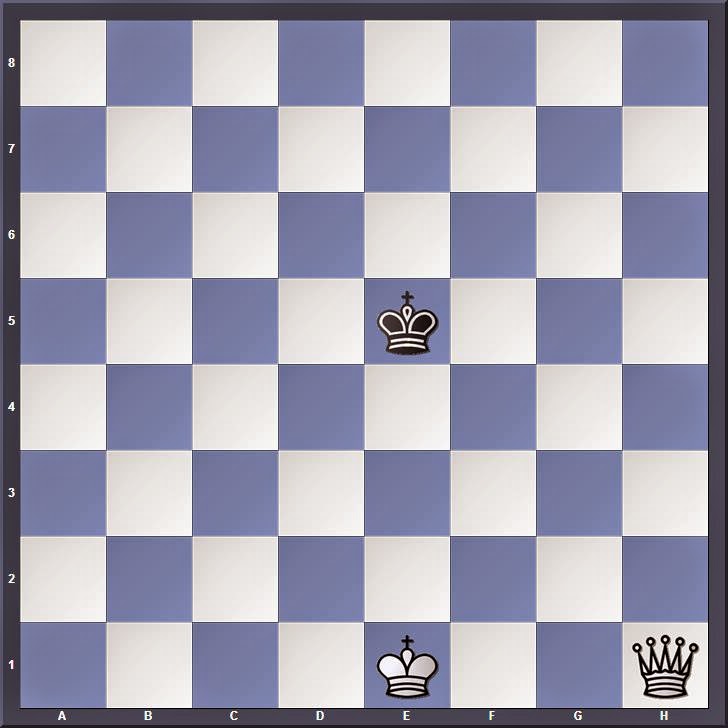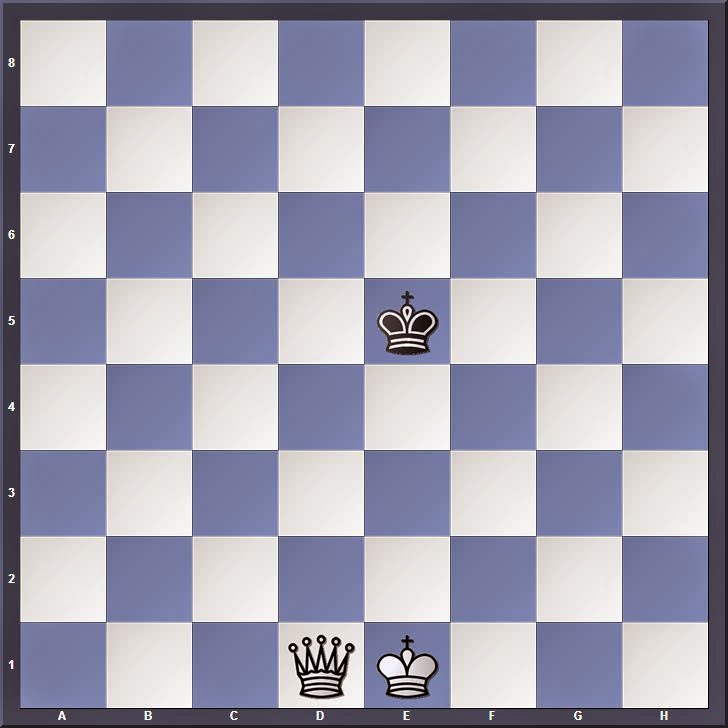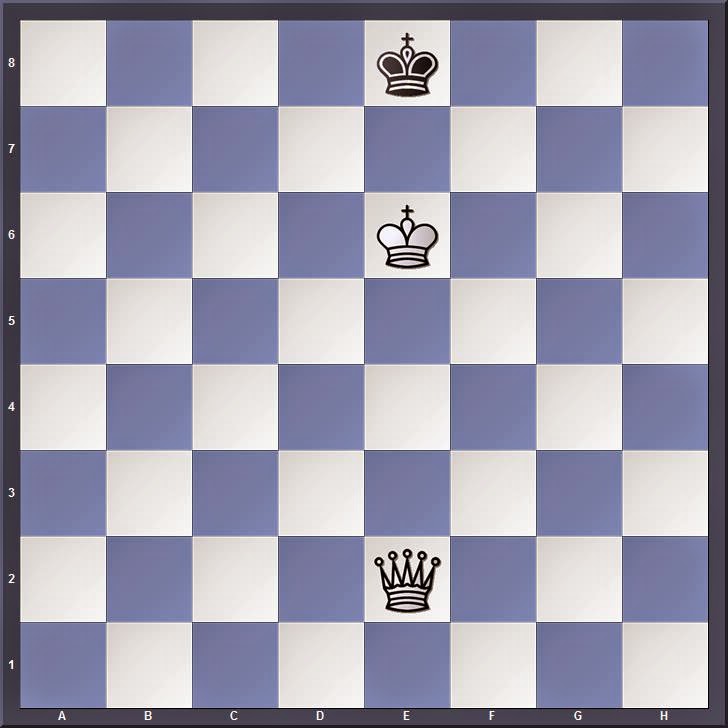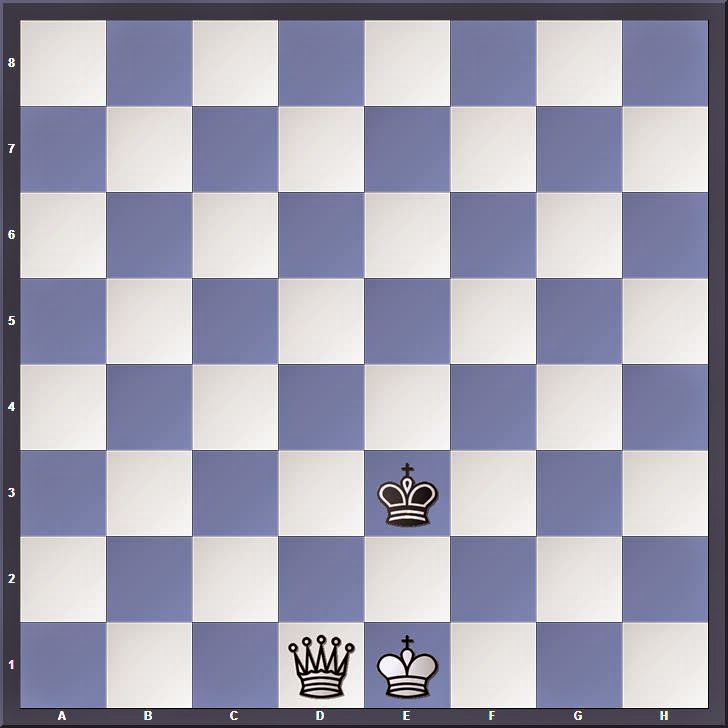How do you teach to young children the elementary checkmate of queen and king versus a lone king? Is it important to stress coordination of the two pieces working in harmony? Does each piece do its work in succession?
In teaching this skill, chess coaches must balance simplicity with efficiency. The best technique may vary from one student to another. When a young player has mastered the technique, self-confidence will develop. Pawn endings become more meaningful.
The simplest way might be to confine the enemy king with a queen until reduced to two or three squares, then bring up the king. On the other hand, this method is cumbersome and inefficient. Many more moves must be played to complete the job. Checkmating in fewer moves requires active coordination of queen and king.
Teaching young players to coordinate their pieces will produce benefits beyond development of this elementary skill. Moreover, coordination is necessary for rook and king versus lone king.
In my beginning chess club yesterday afternoon, I worked with young students one-on-one teaching this elementary checkmate. As preparation, I surveyed several books and other resources to gain a better understanding of the varied approaches to teaching this skill.
Although some chess players learn this checkmate almost as soon as they master the movement of the pieces, others play for years before the absence of this skill is exposed. Every youth tournament that I have directed has produced evidence--draws that should be wins--that the skill is not universal among scholastic chess players.
The basic elements of this checkmate are:
patterns of checkmate
restricting the king ("the box", "the knight's move")
coordinating king and queen
avoiding stalemate
A Lesson in Efficiency
José R. Capablanca, Chess Fundamentals (1921) begins with simple checkmates, including our present concern. His explanation, including diagram, occupies a little more than one page. Coordination and efficiency are highlighted. Capablanca states that the checkmate, "should always be accomplished in under ten moves" (8).*
 |
| Capablanca's Starting Position |
His starting move is 1.Qc6, placing the defending king between the attacking queen and king. On the second turn, the king moves. Capablanca's solution: 1.Qc6 Kd4 2.Kd2 Ke5 3.Ke3 Kf5 4.Qd6 Kg5 [4...Kg4 5.Qg6+] 5.Qe6 Kh4 [5...Kh5 6.Kf4] 6.Qg6 Kh3 7.Kf3 and checkmate next move.
A Lesson in Simplicity
ChessKid.com's curriculum contrasts with Capablanca's in several ways. The instruction fills two standard printer sheets. The starting position of the queen differs but the kings are on the same squares as Capablanca's illustration.
 |
| ChessKid.com's Starting Position |
ChessKid.com's solution (step one): 1.Qd3 Ke6 2.Qd4 Kf7 3.Qe5 Kf8 4.Qe6 Kg7 5.Qf5 Kg8 6.Qf6 Kh7 7.Qg5.
The best elements of this three-part solution is the accompanying vocabulary. In step one, the queen builds a box that confines the king. The weakness is that neither side makes optimal moves. Particularly galling is that Black moves to the edge before being forced there, and White does not then confine the enemy king on the edge.
The Rockford, Illinois Chess Club's one page handout follows a process akin to that on ChessKid.com, but adds the note that a defending king on the edge should be instantly confined by placing the queen on the adjacent rank or file. Had that advice been heeded in ChessKid.com's approach, 3...Kf8 would have been met with 4.Qc7. Step two could then begin.
Mastering the Skill
Jeremy Silman, Silman's Complete Endgame Course (2007) bring's together the best elements of these two contrasting approaches. He begins the section with a discussion of "the box" with examples from both queen and from rook checkmates.
 |
| Trapped in a Box |
 |
| Silman's Starting Position |
After confining the king to a box, Silman brings up the king. His solution offers a good example of the two pieces working together.
Techniques for the Teacher
I have found that it is useful to teach young players how to confine the enemy king without checks. Often I use only two pieces on the board: a white queen and black king. The queen constantly moves a knight's move from the king, shrinking the box until the king is confined to two squares. Then, I place the white king in the far corner. See "Lesson of the Week" (8 November 2011) for illustrations.
When students are older, or stronger, or have mastered this simple exercise, I work on teaching efficient checkmate through coordination of the pieces. In order to earn the Knight Award, players must reach this level.
Two books have proven helpful.
Bruce Pandolfini, Pandolfini's Endgame Course (1988) offers four diagrams for queen and king vs. king. In each one, checkmate is forced in no more than four moves. His verbal descriptions offer guidance useful for executing the checkmate from positions that require more moves. The king must be trapped on an outside row. The queen confines the enemy king by moving "a knight's jump" away. Pandolfini's Endgame 5 (the second with QK vs. K) highlights the stalemate danger when the queen is a knight's jump from a king in the corner. Of particular importance is Pandolfini's expression of the technique of the "cut-off" in this ending and in RK vs. K.
Elements of the Game of Chess (1822) by William Lewis was published without diagrams and using an early version of English descriptive notation. It has been digitized by Google Books, rendering it accessible, but no easier to use. Nonetheless, I find it of value. Lewis presents a series of nine starting positions. The first several are checkmate in one or two.
 |
| Lewis's Starting Position |
After 1...Kd8, two checkmates are possible. 2.Qb8# is given by Lewis. This checkmate pattern is usually omitted from texts aimed at the beginner. However, it is an essential pattern for solving a problem that I created more than ten years ago, and that surprisingly has stymied many accomplished players.
There are three solutions to this problem.
White to move
 |
| Mate in Two (Stripes 2003) |
 |
| Lewis's Starting Position |
1.Qh7 Ke8 2.Qg7 Kd8 3.Qf7 Kc8 and now checkmate is possible two ways: 4.Qc7# or 4.Qe8#.
Lewis seventh position is one that I have used with some frequency to teach coordination between king and queen.
 |
| Lewis's Starting Position |
White's first move confines the defending king in a box by moving the queen a knight's jump away. In this case, however, the white king is also in this box. Such was also true in Capablanca's solution, although he does not mention the box.
Black has one legal move.
1...Kf4 2.Kf2
Again, the defending king has a single legal move.
2...Kg4 3.Qe5
Black now has two choices. 3...Kh3 leads to 4.Qg3#.
3...Kh4 4.Kf3 Kh3
And now there is a choice of checkmates.
Applying Lewis's method to the starting position employed by ChessKid.com, checkmate can be forced in seven moves. Silman offers useful advice: "Study this endgame carefully until you can easily checkmate your friends and your computer" (14).
I have played out this checkmate hundreds of times against the computer. Even under incredible time pressure, finishing this game is like breathing. It has become automatic.
*Several older texts express the view that nine moves is the most that should be required from any position. Computer generated endgame tablebases have demonstrated, however, that perfect play from the hardest position yields checkmate in ten. This position and the optimal solution is given in László Polgár, Chess Endgames (1999) and other sources.













No comments:
Post a Comment